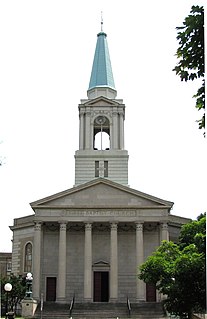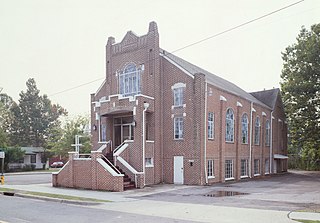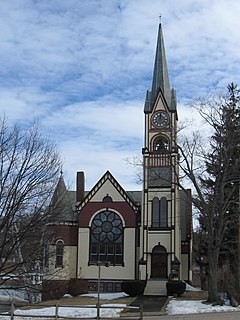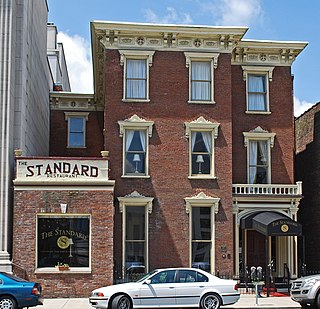
American Baptist College is a private, Baptist college in Nashville, Tennessee, affiliated with the National Baptist Convention, USA. Founded in 1924, its predecessor in black Baptist education was Roger Williams University, a Nashville college begun in the late-19th century and closed in the early 20th century. Upon full accreditation by the American Association of Bible Colleges, ABTS dropped use of the term "Theological Seminary" and renamed itself American Baptist College. The college has an 82% acceptance rate. In Fall 2019, 77% of students were retained after the first year of attendance.

First Baptist Church is a historic church located in Knoxville, Tennessee. It is on the National Register of Historic Places.

Bethel Baptist Church is a Baptist church in the Collegeville neighborhood of Birmingham, Alabama. The church served as headquarters from 1956 to 1961 for the Alabama Christian Movement for Human Rights (ACMHR), which was led by Fred Shuttlesworth and active in the Birmingham during the Civil Rights Movement. The ACMHR focused on legal and nonviolent direct action against segregated accommodations, transportation, schools and employment discrimination. It played a crucial role in the 1961 Freedom Rides that resulted in federal enforcement of U.S. Supreme Court and Interstate Commerce Commission rulings to desegregate public transportation.

Belmont Mansion, also known as Acklen Hall, and originally known as Belle Monte, Belle Mont or Belmont, is a historic mansion located in Nashville, Tennessee. It was built by Joseph and Adelicia Acklen to serve as the center of their 180-acre summer estate in what was then country outside the city, and featured elaborate gardens and a zoo. They lived much of the rest of the year on her plantations in Louisiana.

United Baptist Church of Lakeport is a historic church at 35 Park Street in the village of Lakeport in Laconia, New Hampshire, United States. Built in 1891 after a fire destroyed an older church, it is an eclectic local example of Late Victorian architecture. It was listed on the National Register of Historic Places in 1985.

The Long Creek Academy is a former Christian school that is located at the intersection of Academy Road and South Carolina S-37-339 near U.S. Route 76 near Long Creek, South Carolina in Oconee County. It was named to the National Register of Historic Places on November 20, 1987. It is currently used by a whitewater rafting company.
Edward Emmett Dougherty, a.k.a. Edwin Dougherty was an architect in the southeastern United States. One of his best known designs was the Tennessee War Memorial Auditorium in Nashville in 1922. The work won state and national design competitions.
The following is a timeline of the history of the city of Nashville, Tennessee, United States.

National Baptist Memorial Church is a Baptist church in Washington, D.C. It is located at the intersection of 16th Street NW and Columbia Road, where the Mt. Pleasant, Columbia Heights and Adams Morgan neighborhoods meet. The crossroads is notable for the triple steeples of National Baptist Memorial Church, All Souls Unitarian Church and the Unification Church's cathedral.

Beech Grove is a historic mansion in Nashville, Tennessee, USA. Built as a log house circa 1850, it was a Southern plantation with African slaves in the Antebellum era. In the 1910s, it became a livestock farm.

Belair is a historic mansion in Nashville, Tennessee, USA. Built as a wedding present for Elizabeth Clay, a Southern belle and heiress to the Belle Meade Plantation in the 1830s, it was once the home of William Nichol, a mayor of Nashville.

Longview is a historic mansion in Nashville, Tennessee, USA.

The Southern Methodist Publishing House is a historic building in Nashville, Tennessee, USA.

The McGavock-Gatewood-Webb House, also known as Blue Fountain, is a historic house in Nashville, Tennessee, USA. It was built in the 1840s.

The Morris Memorial Building is a historic building in Nashville, Tennessee, United States. It was built in the 1920s for the African-American National Baptist Convention, USA, Inc. and was named for longtime president Elias Camp Morris.

Lindsley Hall is a historic building in Nashville, Tennessee. Built in the antebellum South as the main building of the University of Nashville, it served as a Union hospital during the Civil War. It became the Nashville Children's Museum in 1945. In 1974 the museum moved to a new facility at 800 Fort Negley Boulevard, became the Cumberland Science Museum and is now known as the Adventure Science Center. The building is once again called Lindsley Hall and is used by the City of Nashville for Metro Government offices.

The Savage House is a historic three-storey townhouse in Nashville, Tennessee, USA.
Henry Gibel was a Swiss-born American architect. He designed many buildings in Tennessee, some of which are listed on the National Register of Historic Places.
Donald W. Southgate (1887–1953) was an American architect. He designed many buildings in Davidson County, Tennessee, especially Nashville and Belle Meade, some of which are listed on the National Register of Historic Places.
Edwin Augustus Keeble was an American architect who was trained in the Beaux-Arts architecture tradition. He designed many buildings in Tennessee, including homes, churches, military installations, skyscrapers, hospitals and school buildings, some of which are listed on the National Register of Historic Places. He is best known for Nashville's landmark Life and Casualty Tower built in 1957 which was the tallest commercial structure in the Southeastern United States at that time. It reflected an architectural turn to modernism and was one of the first buildings emphasizing energy efficiency.

















